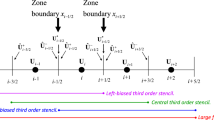Abstract
In this article, we study the numerical solution of singularly perturbed non-linear autonomous initial-value problems by a non-standard algorithm on layer-resolving nonuniform meshes. Here, we use the piecewise-uniform Shishkin meshes, and two other nonuniform meshes which resolve the difficulties arising from the steep gradient of the solution in the initial layer. The present method is intended for solving the nonlinear problem without linearization and provides third-order convergence results. Linear stability of this method is studied. Numerical experiments are carried out to verify the efficiency and accuracy of the method.
Similar content being viewed by others
References
Aris R.: On stability criteria of chemical reaction engineering. Chem. Eng. Sci. 24, 149–169 (1968)
Benzinger W., Becker A., Hüttinger K.J.: Chemistry and kinetics of chemical vapour deposition of pyrocarbon: I. Fundamentals of kinetics and chemical reaction engineering. Carbon 34, 957–966 (1996)
Burghardt A., Zaleski T.: Longitudinal dispersion at small and large Peclet numbers in chemical flow reactors. Chem. Eng. Sci. 23, 575–591 (1968)
Cohen D.S.: Multiple stable solutions of nonlinear boundary value problems arising in chemical reactor theory. SIAM. J. Appl. Math. 20(1), 1–13 (1971)
Cohen D.S., Laetsch T.W.: Nonlinear boundary value problems suggested by chemical reactor theory. J. Differ. Equ. 7, 217–226 (1970)
Danish M., Sharma R.K., Ali S.: Gas absorption with first order chemical reaction in a laminar falling film over a reacting solid wall. Appl. Math. Model. 32, 901–929 (2008)
Doolan E.P., Miller J.J.H., Schildres W.H.A.: Uniform Numerical Methods for Problems with Initial and Boundary Layers. Boole Press, Dublin (1980)
Farrell P.A.: Uniform and optimal schemes for stiff initial-value problems. Comput. Math. Appl. 13, 925–936 (1987)
Jain M.K.: Numerical Solution of Differential Equations. Wiley Eastern Limited, New Delhi (1984)
Liu Y., Shen L.: A general rate law equation for biosorption. Biochem. Eng. J. 38, 390–394 (2008)
Liu Y.: New insights into pseudo-second-order kinetic equation for adsorption. Colloids Surf. A 320, 275–278 (2008)
Lovas R., Kacsuk P., Lagzi I., Turányi T.: Unified development solution for cluster and grid computing and its application in chemistry. Lect. Notes Comput. Sci. 3044, 226–235 (2004)
Miller J.J.H.: Optimal uniform difference schemes for linear initial-value problems. Comput. Math. Appl. 12, 1209–1215 (1986)
Miller J.J.H., O’Riordan E., Shishkin G.I.: Fitted Numerical Methods for Singular Perturbation Problems. World Scientific, Singapore (1996)
Natesan S., Ramanujam N.: Initial-value technique for singularly perturbed boundary-value problems for second-order ordinary differential equations arising in chemical reactor theory. J. Optim. Theory Appl. 97(2), 455–470 (1998)
Natesan S., Ramanujam N.: A booster method for singular perturbation problems arising in chemical reactor theory. Appl. Math. Comput. 100, 27–48 (1999)
Natesan S., Vigo-Aguiar J., Ramanujam N.: A numerical algorithm for singular perturbation problems exhibiting weak boundary layers. Comput. Maths. Appl. 45, 469–479 (2003)
O’Malley R.E.: Introduction to Singular Perturbation. Academic Press, New York (1974)
Ramos H.: A non-standard explicit integration scheme for initial-value problems. Appl. Math. Comput. 189, 710–718 (2007)
Ramos H., Vigo-Aguiar J.: A new algorithm appropriate for solving singular and singularly perturbed autonomous initial-value problems. Int. J. Comput. Math. 85, 603–611 (2008)
Rao C.V., Wolf D.M., Arkin A.P.: Control, exploitation and tolerance of intracellular noise. Nature 420, 231–237 (2002)
Reilly M.J.O, O’Riordan E.: A Shishkin mesh for a singularly perturbed riccati equation. J. Comput. Appl. Math. 182, 372–387 (2005)
Rudzinski W., Plazinski W.: Kinetics of solute adsorption at solid/solution interfaces: a theoretical development of the empirical pseudo-first and pseudo-second order kinetic rate equations, based on applying the statistical rate theory of interfacial transport. J. Phys. Chem. B 110, 16514–16525 (2006)
Vigo-Aguiar J., Natesan S.: A parallel boundary value technique for singularly perturbed two-point boundary value problems. J. Supercomput. 27, 195–206 (2004)
Author information
Authors and Affiliations
Corresponding author
Rights and permissions
About this article
Cite this article
Ramos, H., Vigo-Aguiar, J., Natesan, S. et al. Numerical solution of nonlinear singularly perturbed problems on nonuniform meshes by using a non-standard algorithm. J Math Chem 48, 38–54 (2010). https://doi.org/10.1007/s10910-009-9625-2
Received:
Accepted:
Published:
Issue Date:
DOI: https://doi.org/10.1007/s10910-009-9625-2




